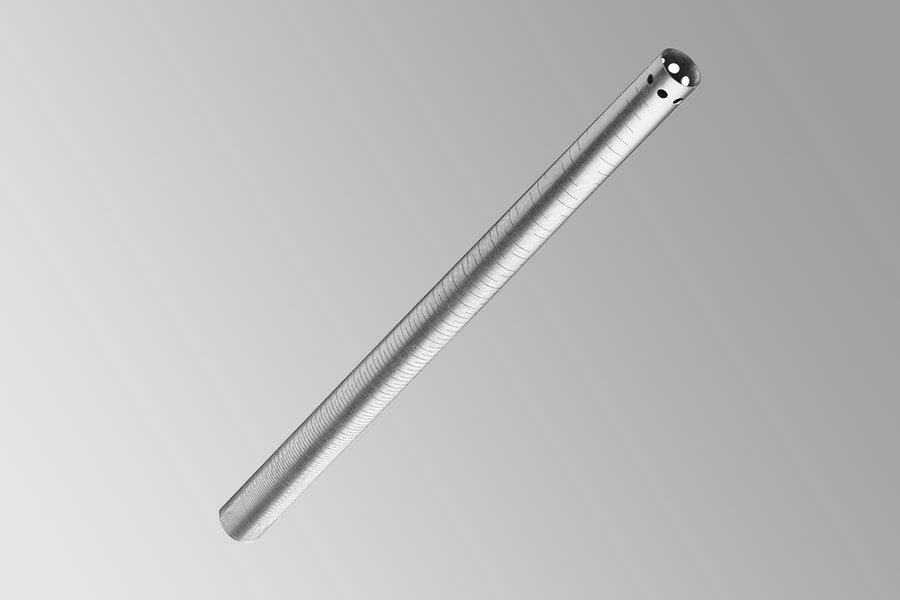Laser Cut Hypotubes
Laser cut hypodermic tubes (hypotubes) are small-diameter tubes that have been precisely cut using laser technologies. Hypotubes are commonly used in catheter assemblies.

Laser Cut Hypotubes
Laser cut hypodermic tubes (hypotubes) are small-diameter tubes that have been precisely cut using laser technologies. Hypotubes are commonly used in catheter assemblies.

Hypotubes are thin, flexible metal tubes that are used in a variety of medical procedures. Cutting patterns into these tubes with lasers that create highly precise flexibility has become the industry standard; laser cutting creates detailed features that are not achievable with other manufacturing methods, as well as eliminates the potential for burrs or other defects.
Laser cut hypotubes are often key components in interventional devices such as flexible catheter shafts and delivery systems that are designed to navigate highly complex anatomy. The accuracy of laser cutting allows medical device engineers to custom-design hypotube-catheter systems to match a specific path through complex anatomy.
The flexibility of hypotubes is the result of patterns that are cut in the surface of the tube. The length of the cuts and the pitch between the cuts define how flexible the hypotube will be along its length. The location and precision of the cuts are critical for ensuring the hypotube will perform correctly during the procedure and create less tissue trauma. Some examples of laser cut patterns that create different types of flexibility in hypotubes are:
Laser cutting is typically a fully automated process that ensures the highest quality, precision, and repeatability for this delicate medical product is achieved.
Laser cut hypotubes are used extensively in the medical field in association with catheters, guide wires, and other interventional devices. Hypotubes must be small enough and flexible enough to navigate complex vasculature to direct minimally-invasive tools and devices, or deliver drugs to specific target areas. Enhanced flexibility, pushability, and torque contribute to shorter and less stressful procedures for both patients and medical staff.
In addition to medical applications, laser cut hypotubes are also used in industrial sectors for tasks such as fluid delivery, sensing, and precision instrumentation.
Spectrum’s design engineers collaborate with customer design teams and share expertise to design the best possible product design and manufacturing process. Design for manufacturability (DFM) is a vital step in developing a high-quality, repeatable, cost-effective manufacturing process that meets or exceeds all technical specifications and performance expectations.
DFM discussions evaluate mechanical characteristics such as inside and outside diameters, wall tolerances, wall thicknesses, and shape transitions. Performance requirements include pushability and kink resistance, which are typically improved compared to traditional reinforced catheters. Exit markers are also important navigation features on hypotubes that can be added with laser cutting.
Spectrum’s high-precision laser systems deliver custom hypotube designs in a cost-effective and timely manner. By utilizing stage repeatability at a sub-micron level and multiple laser types, Spectrum engineers can produce the highest-quality hypotubes with high-precision micron-sized features, for the most challenging applications.
Hypodermic tubes (hypotubes) are small-diameter tubes that have been precisely cut using laser technologies. Patterns are cut in the surface of the tube to control flexibility along the tube.
Laser cut hypotubes are used in interventional devices such as flexible catheter shafts to direct the use or placement of medical/surgical tools and devices, or the delivery of drugs, to specific target areas.
Laser cut hypotubes are typically made of stainless steel or other metals such as Nitinol (a nickel-titanium alloy) or platinum, which provide biocompatibility, strength, and corrosion resistance.
With ultra-fast (1 fs = 10−15 s) pulses of laser light, femtosecond lasers can cut features that are as small as a few microns, with submicron tolerances.